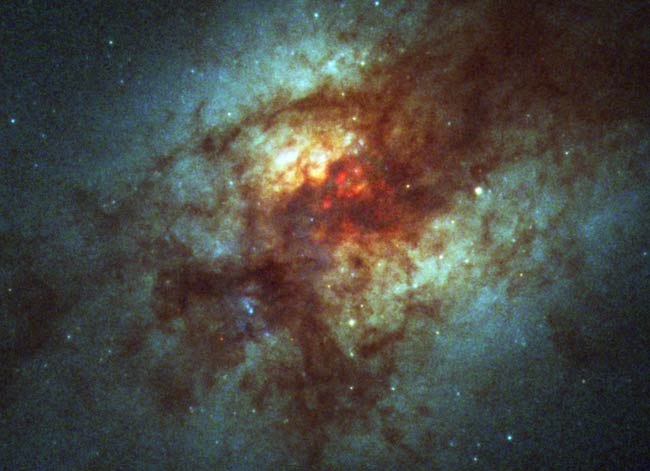
Astronomershave uncovered a frenzy of star forming activity in the dusty cores of twomerging galaxies 250 million light-years away.
With theaid of NASA's Hubble Space Telescope, the researchers spied more than 200mammoth star clusters in Arp 220,an uber-galaxy in the constellation Serpens that is forming as the result of agalactic collision that began about 700 million-years ago.
The starclusters are packed into a very small region only about 5,000 light-yearsacross. The biggest cluster contains nearly 10 million suns worth of matter andis twice as massive as any star cluster ever discovered in the Milky WayGalaxy.
"Thisis star birth in the extreme," said study team member Christine Wilson ofthe McMaster University in Canada. "This is a nearby look at aphenomenon that was common in the early universe, when many galaxies weremerging."
The clustersare so compact that even though they lie only a moderate distance away, theylook like single stars. What gives them away as star clusters, however, is thatthey shine brighter than any single star would at that distance.
The findings, detailed in the April 20 issue of AstrophysicalJournal, are based on 2002 observations with Hubble's Advanced Camera forSurveys and on previous data collected by the Near Infrared Camera andMulti-Object Spectrometer. The star clusters could yield insights about starevolution and about the early universe, when galaxymergers were more common.
Get the Space.com Newsletter
Breaking space news, the latest updates on rocket launches, skywatching events and more!
Created in fits or gradually?
Theresearchers measured the masses and ages for 14 of the clusters and then usedthis information to estimate the masses and ages for all of the clusters. Theanalysis revealed two different cluster populations: One that was less than 10million years old and another that was 70 million to 500 million years old.
The youngerclusters were more massive than the older ones.
It's stillunclear if the clusters were created at two different epochs or whether theywere created gradually over a long period of time and astronomers are just notseeing the intermediate-aged ones.
What isknown, however, is that the starbursts were sparked by the collision of the twoparent galaxies that make up Arp 220. Radio data show two objects 1,000light-years apart which might be the cores of the original galaxies.
Poweredby dust
Arp 220 is a so-called ultra-luminous infrared galaxy, orULIRG, and glows brilliantly in the infrared because its dust has been superheatedby starlight.
If not for the thick layer of dust that enshrouds the entiregalaxy, Arp 220 would shine 50 times brighter than our galaxy. It's the gas,however, that fuels star birth in the clusters. It is estimated that there isas much gas in the tiny region where the star clusters were discovered as thereis in the rest of the entire Milky Way.
Scientists think Arp 220 will continue to produce starclusters for about another 40 million years, at which time all of its gas willbe exhausted. When the gas is gone, Arp 220 will look like a regular ellipticalgalaxy, which has little gas. However, some of newly discovered star clusterswill still be visible.
Wilson recently announced a surprisingfinding involving Arp 220 and similar highly active galaxies: In terms oftheir mix of gas vs. dust, they are very similar to our more mature Milky Way.
- Star Clusters Hold Secrets to Stellar Evolution
- What a Shock! Galaxies Caught Colliding
- Image Gallery: Hubble Space Telescope: Greatest Hits
- Image Gallery: Hubble's New Views of the Universe
Join our Space Forums to keep talking space on the latest missions, night sky and more! And if you have a news tip, correction or comment, let us know at: community@space.com.
Ker Than is a science writer and children's book author who joined Space.com as a Staff Writer from 2005 to 2007. Ker covered astronomy and human spaceflight while at Space.com, including space shuttle launches, and has authored three science books for kids about earthquakes, stars and black holes. Ker's work has also appeared in National Geographic, Nature News, New Scientist and Sky & Telescope, among others. He earned a bachelor's degree in biology from UC Irvine and a master's degree in science journalism from New York University. Ker is currently the Director of Science Communications at Stanford University.
